Fused ring compound and method for producing same, polymer, organic thin film containing those, and organic thin film device and organic thin film transistor comprising such organic thin film
a technology of ring compound and ring compound, which is applied in the direction of organic chemistry, luminescent compositions, thermoelectric devices, etc., can solve the problems of insufficient charge transport properties and formation of organic thin films, and achieve excellent charge transport properties, excellent solubility in solvents, and sufficient charge transport properties.
- Summary
- Abstract
- Description
- Claims
- Application Information
AI Technical Summary
Benefits of technology
Problems solved by technology
Method used
Image
Examples
synthesis example 1
Synthesis of 3,3′-diiodo-2,2′-bithiophene
[0125]First, the starting raw material 3,3′-dibromo-2,2′-bithiophene was synthesized by referring to the description in a reference document (Hong M., Wei H., J. Org. Chem., 2000, 65, 3895). Then, a halogen exchange reaction was carried out using this starting raw material to synthesize 3,3′-diiodo-2,2′-bithiophene. Specifically, first, a three-necked 300 mL flask was charged with 3,3′-dibromo-2,2′-bithiophene (2.7 g (7 mmol)), which was then dissolved in diethyl ether (70 mL). Next, the contents of the reaction vessel were purged with nitrogen and the vessel was cooled to −78° C. Then, the vessel was charged with butyllithium (in 1.5 M hexane solution, 10.3 mL (15.4 mmol)), and the resultant solution was stirred for 1 hour. Iodine (3.9 g (15.4 mmol) dissolved in diethyl ether was further charged thereto, and the resultant solution was reacted by stirring for 1 hour at room temperature.
[0126]The post-reaction solution was charged with diethyl...
example 1
Synthesis of 4,5-di(n-propyl)benzo[2,1-b:3,4-b′]dithiophene
[0127]A two-necked 20 mL flask was charged with 3,3′-diiodo-2,2′-bithiophene (84 mg (0.2 mmol)), palladium(II) acetate (4.5 mg (0.02 mmol)), 4-octyne (66 mg (0.6 mmol)), N,N-dicyclohexylmethylamine (117 mg (0.6 mmol)), and N,N-dimethylformamide (2.5 mL). The contents of the reaction vessel were purged with nitrogen, and a reaction was then carried out under stirring by heating at 100° C. Four hours later, it was confirmed by GC and GC-MS analysis that 4,5-di(n-propyl)benzo[2,1-b:3,4-b′]dithiophene was roughly quantitatively (GC yield of 99% or more) formed in the reaction mixture.
[0128]Next, the obtained reaction solution was charged with diethyl ether (about 20 mL), and the resultant solution was then washed with water. Subsequently, the organic layer was dried over sodium sulfate, and then filtered over Celite. The solvent was removed from the filtrate by distillation, and then the remaining liquid was purified by silica g...
example 2
[0131]A reaction was carried out in the same manner as in Example 1, except that tributylamine (111 mg (0.6 mmol)) was used instead of N,N-dicyclohexylmethylamine, and the reaction time was 8 hours. After the reaction, it was confirmed from GC and GC-MS analysis that 4,5-di(n-propyl)benzo[2,1-b:3,4-b′]dithiophene was roughly quantitatively (GC yield of 99% or more) formed in the reaction mixture.
PUM
| Property | Measurement | Unit |
|---|---|---|
| charge (electron or hole) transport properties | aaaaa | aaaaa |
| charge transport properties | aaaaa | aaaaa |
| solubility | aaaaa | aaaaa |
Abstract
Description
Claims
Application Information
 Login to View More
Login to View More - R&D
- Intellectual Property
- Life Sciences
- Materials
- Tech Scout
- Unparalleled Data Quality
- Higher Quality Content
- 60% Fewer Hallucinations
Browse by: Latest US Patents, China's latest patents, Technical Efficacy Thesaurus, Application Domain, Technology Topic, Popular Technical Reports.
© 2025 PatSnap. All rights reserved.Legal|Privacy policy|Modern Slavery Act Transparency Statement|Sitemap|About US| Contact US: help@patsnap.com



